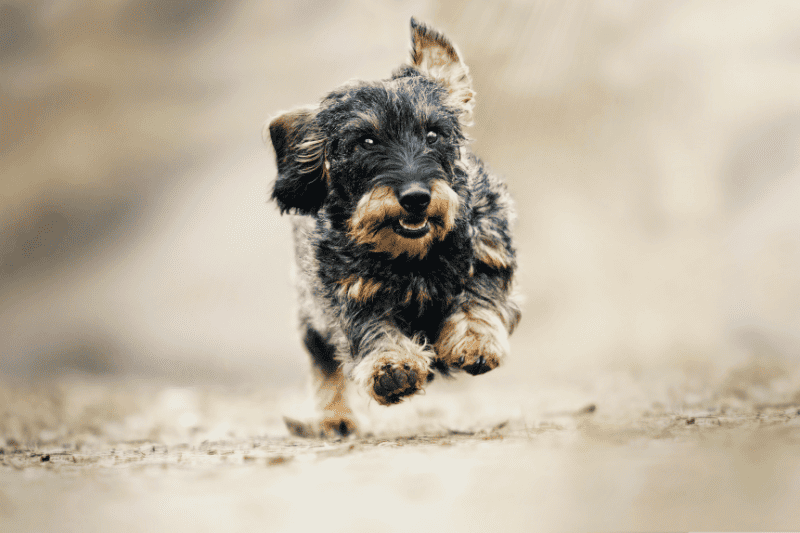
Dachshunds are adorable and lively dogs that require regular exercise to stay healthy and happy. Exercise is essential for maintaining a healthy weight, preventing obesity, promoting good circulation, and keeping the dog’s joints and muscles strong. Furthermore, exercise also provides mental stimulation and can reduce anxiety and boredom.
However, many Dachshund owners may have concerns and questions about their exercise needs, such as how much exercise is enough or too much, what types of exercises are best for them, and what activities should be avoided. In this article, we will explore Dachshund’s exercise needs and provide some practical tips and recommendations for exercising your furry friend.
Related post: Why Does My Dog Go Crazy at Night?
How long should a Dachshund walk?
Dachshunds are energetic dogs that enjoy daily walks; however, how much walking is enough for them? The general recommendation for miniature dachshunds is to walk for at least 30 minutes a day. Standard dachshunds usually need around 45 minutes to an hour of daily exercise. However, the actual walking time and frequency can vary depending on several factors, such as the dog’s age, weight, and health condition.
For example, younger and more active Dachshunds may need longer or more frequent walks, while senior or overweight Dachshunds may require shorter and slower walks. As a general rule, you should adjust the walking routine based on your Dachshund’s physical and mental needs and avoid pushing them beyond their limits.
It is also important to avoid insufficient or excessive walking, as both can have negative consequences. Insufficient walking can lead to weight gain, muscle weakness, and joint stiffness, whereas excessive walking can cause fatigue, dehydration, and even injuries. If you are unsure about the ideal walking routine for your dachshund, consult your veterinarian for personalized advice.
Related post: How far can dachshunds walk?
What is the best exercise for dachshunds?
Dachshunds are versatile dogs that can benefit from different types of exercise. The best exercise for your dachshund depends on their age, fitness level, and interests; however, some of the most popular and effective types of exercise include:
- Walking: Walking is an easy and low-impact exercise that can benefit dachshunds of all ages and fitness levels. It can improve cardiovascular health, promote weight loss, and provide mental stimulation. However, walking alone may not suffice for the high energy levels of some dachshunds.
- Swimming: Swimming is a great exercise for Dachshunds, as it is gentle on their joints and can improve their overall fitness. It can also help Dachshunds with arthritis or mobility issues to move more comfortably. However, not all Dachshunds are natural swimmers, so it is essential to introduce them to water gradually and supervise them at all times.
- Agility training: Agility training is a fun and challenging exercise that can enhance your dachshund’s physical and mental abilities. It involves navigating through obstacle courses, jumping over hurdles, and weaving through poles; however, it is not recommended for dachshunds with back or joint problems as it can cause injury.
- Interactive play: Interactive play, such as fetch, tug-of-war, and hide-and-seek, is an excellent way to bond with your dachshund and provide them with mental and physical stimulation. It can also improve their coordination, balance, and problem-solving skills. However, it is crucial to supervise the play and avoid over-excitement or rough play that could lead to injury.
To create a balanced exercise routine for your dachshund, it is best to combine different types of exercise and adjust the intensity and duration based on their needs. For example, you can start with a brisk walk, followed by some swimming or interactive play, and finish with some gentle stretching or massage. Always monitor your dachshund’s body language and behavior, and stop the exercise if they show signs of discomfort or fatigue.
Related post: How to tire out a Dachshund

Can you exercise a Dachshund too much?
Exercise is an essential component of a dachshund’s well-being, however, it must be done in moderation as too much can lead to a plethora of health problems. Dachshunds are more susceptible than other breeds when it comes to back issues, making them particularly vulnerable to over-exercising; exhaustion, dehydration, and injury may arise if caution isn’t taken. Consider the following risks associated with excessive exercise for your pup:
- Joint and back problems: Dachshunds have long spines and short legs, making them more susceptible to back injuries, especially if they engage in activities that involve jumping or twisting. Over-exercising can also lead to joint problems such as hip dysplasia or arthritis.
- Dehydration and heat exhaustion: Dachshunds are sensitive to hot weather and can quickly overheat and become dehydrated if they exercise for too long. Signs of dehydration and heat exhaustion include excessive panting, drooling, and lethargy.
- Muscle strains and sprains: Dachshunds can easily strain or sprain their muscles, particularly if they engage in high-intensity activities without proper warm-ups or cool-downs.
To keep your dachshund safe, it is important to observe their body language and behavior. Warning signs of over-exercising include heavy panting, saliva dripping from the mouth, limping, or unwillingness to move. Instantly stop exercising if any of these indicators appear and offer your pup water along with a comfortable spot for resting. Additionally, progressively build the intensity and duration when exercising as well as ensure that they have enough breaks in shaded areas where they can properly cool down before continuing again.
Ignoring your dachshund’s exercise requirements can have serious repercussions, such as obesity and boredom to destructive behavior. Therefore, you must come up with a balanced workout routine tailored to their needs and likes which will help them stay healthy both physically and mentally.
Related post: How to Keep a Dachshund Busy

Is it OK to run with Dachshunds?
Unleashing the power of running with your Dachshund can be a rewarding and fun way to help them work out their energy. Before you break into a sprint alongside your pup, there are some do’s and don’ts that should be noted. Let’s take a look at how to skillfully keep up with your active Dachshund on the road!
Benefits and risks of running with dachshunds:
For many dachshunds, running can be a difficult high-impact activity on the joints and back. That being said, it is also an effective way to build endurance and keep your pup’s weight in check. A routine may even improve cardiovascular health as well as increase muscle tone – all beneficial for dogs with existing conditions or extra pounds!
To keep your dachshund healthy and comfortable while running, it’s crucial, to begin with, a slow pace and gradually build up the duration. Furthermore, make sure your pup has plenty of rest and hydration throughout the run to refuel its energy reserves. Lastly, be mindful of signs of exhaustion or discomfort that may indicate rest is needed!
Tips for running with dachshunds:
- Consult with your vet: Before starting a running program with your dachshund, it is essential to consult with your vet to ensure that your dachshund is healthy and fit enough for the activity.
- Choose a suitable surface: Dachshunds have delicate joints and are more susceptible to injuries on hard surfaces, such as concrete or pavement. Therefore, opt for softer surfaces, such as grass or dirt trails, to reduce the impact on their joints.
- Use a harness instead of a collar: Dachshunds are prone to back problems, and using a collar can put undue pressure on their necks and spines. A harness can help distribute the pressure more evenly and reduce the risk of injury.
- Watch for signs of fatigue or pain: Dachshunds are stoic animals and may not show signs of pain or discomfort until it is too late. Watch for signs such as limping, panting, or reluctance to move, and stop the run immediately if you notice any of these signs.
Enjoy the beauty of running with your dachshund, but remember that it is important to be aware of their needs and limitations to keep them safe. Take it slow and focus on providing a rewarding experience for both you and your pup!
Related post: Is Running Bad for Dachshunds?
Can Dachshunds swim?
Despite their unique physique, dachshunds can indeed swim. However, it is critical to remember that not all of these adorable pups are natural swimmers due to their short legs and long body structure. Additionally, some may be averse to the water or even fearful while in it – so make sure your pup is comfortable before venturing out into deep waters.
Introducing your dachshund to swimming should be done with caution and patience. Start by allowing them to explore shallow water, ensuring they feel comfortable. From there, you can slowly increase the depth of the pool while providing a flotation device for support if needed. Above all else, though, never leave your pup unattended! Make sure that both their energy levels and safety are monitored throughout this process so that it goes smoothly without any hiccups along the way.
Swimming can be an excellent form of low-impact exercise to improve endurance and strength; yet, you must meet with your veterinarian if your dachshund has any pre-existing health issues. This will ensure they are safe while in the water. Most importantly, when adding swimming as part of their physical activity routine, safety should always come first.
Related post: Can Dachshunds Swim?

What are the dangers of not exercising your dachshund?
If you don’t provide regular exercise for your dachshund, the consequences can be serious. Dachshunds are quite active and require lots of physical activity to stay healthy; ignoring their need for exercise puts them at risk of obesity, muscle loss, and overall decreased health. In addition to this, inadequate stimulation can also lead to behavioral issues such as boredom or even depression. To keep your dog happy and safe from harm, make sure that they get plenty of playtimes each day!
Additionally, an inactive lifestyle can increase the odds of developing health difficulties such as back injuries, joint pain, and heart disease. Dachshunds in particular are especially vulnerable to spine-related issues because their long spines don’t match their short legs. Without consistent exercise and proper maintenance, a dachshund’s back may become weak and more prone to problems like intervertebral disc disease.
Ensuring your dachshund gets adequate exercise is essential for their overall health and well-being. Ignoring this need can lead to serious physical and behavioral issues, so be sure to make daily physical activity a priority in your routine.
Related post: Are dachshunds good hiking dogs?
Conclusion
Ultimately, exercise is essential for the health and happiness of any dachshund. As discussed previously, walking is one ideal way to stay active while taking into account your pup’s age and physical condition. Additionally, swimming or playing fetch can be other helpful exercises; however, it is necessary to ensure that these activities are done responsibly and in moderation.
It is vital to be mindful of the risks associated with over-exercising your dachshund, such as back injuries, joint issues, and overheating. Keeping a close eye on signs of physical strain when exercising will help ensure you are providing them with the appropriate amount. By adjusting their exercise routine accordingly, you can prevent any potential health hazards from occurring.
Ultimately, it is fundamental to avoid or limit certain tasks and activities that can be destructive or perilous for dachshunds. By keeping these considerations in mind, we can guarantee that our beloved pups remain healthy and contented over the years!
Related post: A Guide To Dachshund Diet and Exercise
Recent Posts
Calculate the perfect food portions for your dachshund with our specialized calculator. Get customized feeding recommendations based on size, age, and activity level to support your wiener dog's back...
Looking for the perfect gift for a proud dachshund mom? We’ve rounded up the cutest dachshund shirts that celebrate your love for wiener dogs in style. Whether you’re shopping for yourself or a...


